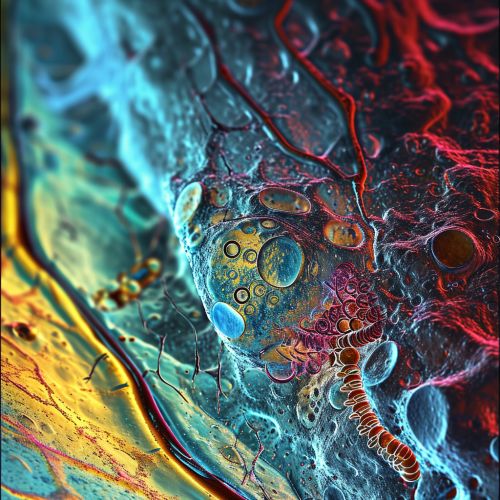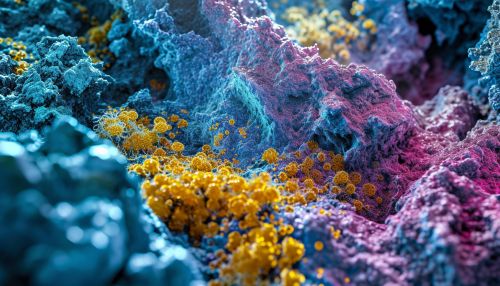ESCRT machinery
Overview
The Endosomal Sorting Complex Required for Transport (ESCRT) machinery is a set of protein complexes involved in membrane remodeling processes such as multivesicular body (MVB) biogenesis, autophagy, and cytokinesis. The ESCRT machinery is highly conserved across eukaryotes, indicating its fundamental role in cellular function.


Structure and Components
The ESCRT machinery is composed of five main complexes: ESCRT-0, ESCRT-I, ESCRT-II, ESCRT-III, and the associated AAA-ATPase Vps4. Each complex plays a distinct role in the ESCRT pathway, working in a sequential manner to facilitate membrane deformation and vesicle formation.
ESCRT-0
ESCRT-0 is composed of two subunits, Hrs (hepatocyte growth factor-regulated tyrosine kinase substrate) and STAM (signal transducing adaptor molecule). This complex is responsible for recognizing and sequestering ubiquitinated cargo proteins at the endosomal membrane.
ESCRT-I
ESCRT-I is a heterotetramer composed of Tsg101 (tumor susceptibility gene 101), Vps28, Vps37, and Mvb12/Ubc9. This complex is responsible for further sequestering ubiquitinated cargo and for initiating membrane deformation.
ESCRT-II
ESCRT-II is a heterotetramer composed of two copies of Vps25, one copy of Vps22, and one copy of Vps36. This complex is involved in membrane deformation and acts as a bridge between ESCRT-I and ESCRT-III.
ESCRT-III
ESCRT-III is composed of several different proteins, including Snf7, Vps24, Vps2, and Vps20. This complex is responsible for the final stages of membrane deformation and vesicle scission.
Vps4
Vps4 is an AAA-ATPase that is associated with the ESCRT machinery. It is responsible for disassembling the ESCRT-III complex and recycling ESCRT components back to the cytosol.
Function
The primary function of the ESCRT machinery is to facilitate the formation of MVBs, which are involved in the degradation of membrane proteins. The ESCRT machinery also plays a role in other cellular processes, such as autophagy and cytokinesis.
Multivesicular Body Biogenesis
In MVB biogenesis, the ESCRT machinery is responsible for the sequestration of ubiquitinated cargo proteins into vesicles that bud into the lumen of the endosome. These vesicles are then delivered to the lysosome for degradation.
Autophagy
In autophagy, the ESCRT machinery is involved in the closure of the autophagosome, a double-membrane vesicle that engulfs cellular components for degradation.
Cytokinesis
In cytokinesis, the ESCRT machinery is involved in the final stages of cell division, facilitating the abscission of the midbody to form two separate cells.
Clinical Significance
Defects in the ESCRT machinery have been linked to various diseases, including cancer, neurodegenerative diseases, and viral infections.
Cancer
In cancer, mutations in ESCRT components can lead to dysregulated protein degradation and signaling, promoting tumorigenesis.
Neurodegenerative Diseases
In neurodegenerative diseases, defects in the ESCRT machinery can lead to the accumulation of toxic protein aggregates, contributing to neuronal cell death.
Viral Infections
In viral infections, many viruses hijack the ESCRT machinery to facilitate their own replication and release from the host cell.
